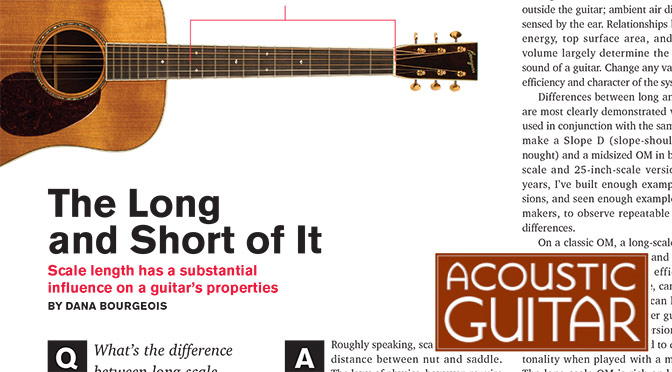Homepage News, Guitar Guru
Guitar Guru – Scale Length
Dana Bourgeois contributes the monthly Guitar Guru column to Acoustic Guitar Magazine. If you a question you’d like Dana to address in an upcoming article, please submit it to [email protected].
Download the PDF of this article here
The Long and Short of It – Scale length has a substantial influence on a guitar’s properties
Q:What’s the difference between long-scale and short-scale guitars, and what are the advantages and disadvantages of each? Henry J. Lewis Lompoc, California
A:Roughly speaking, scale length is the distance between nut and saddle. The laws of physics, however, require that saddles be placed a bit beyond the length of the scale. Actual scale length can be determined by doubling the distance between the nut and the center of the 12th fret.
A scale length of 25.4 inches, 25.5 inches, or longer is considered long for steel-string acoustic guitars; anything less is considered short. Commonly used short scales are 25, 24.9, 24.75, and 24.625 inches. Nylon-string and classical guitars have different categories of long and short scale, most are longer than 25.5 inches.
Scale length can have a significant effect on playability. All factors being equal (string gauge, string length beyond the nut and saddle, break angles, and so on), shorter scales produce lower string tension, are more elastic, easier to fret, and require less arm extension. On the downside, a shorter, slacker string travels further when plucked or strummed and is more prone to buzzing and fret rattling when played at higher dynamic levels.
To understand sonic differences between scale lengths, it’s helpful to visualize how acoustic guitars create sound. In the simplest model, vibrating strings drive a diaphragm (the top), creating air pressure disturbances within an enclosure (the body). Pressure waves escape through the soundhole and disturb the air outside the guitar; ambient air disturbances are sensed by the ear. Relationships between string energy, top surface area, and enclosed air volume largely determine the characteristic sound of a guitar. Change any variable, and the efficiency and character of the system is altered.
Differences between long and short scales are most clearly demonstrated when both are used in conjunction with the same body style. I make a Slope D (slope-shouldered dreadnought) and a midsized OM in both 25.5-inch-scale and 25-inch-scale versions. Over the years, I’ve built enough examples of all versions, and seen enough examples by different makers, to observe repeatable characteristic differences.
On a classic OM, a long-scale string length drives a medium-sized top and medium-sized air enclosure with hyper efficiency. These guitars have power to spare, can be flatpicked or played fingerstyle, and can have presence and headroom to rival larger guitars. In comparison, the short-scale version is an evenly balanced system, well-suited to developing full tonality when played with a medium touch. The long-scale OM is rich and powerful, the short-scale sweet and full.
The long-scale Slope D, with relatively large top surface and large air enclosure, is the evenly balanced version, comparable in power, volume, and articulation to its square-shouldered dreadnought cousin. Lessen energy input at the front end of the system by shortening scale length, and the result is OK—though not ideal—for flatpicking. But it’s a much better fingerpicker than square- or slope-shouldered dreads with long scale lengths, and maybe the best strumming machine known to man.
Players are well advised to consider the ability of scale length to critically alter factors such as playability, tonality, and headroom. Magic happens when good wood and good design come together in a package that’s just right for your playing style.

